Citroen C5 RHD 2015 (RD/TD) / 2.G Owner's Manual
Manufacturer: CITROEN, Model Year: 2015, Model line: C5 RHD, Model: Citroen C5 RHD 2015 (RD/TD) / 2.GPages: 362, PDF Size: 32.4 MB
Page 221 of 362
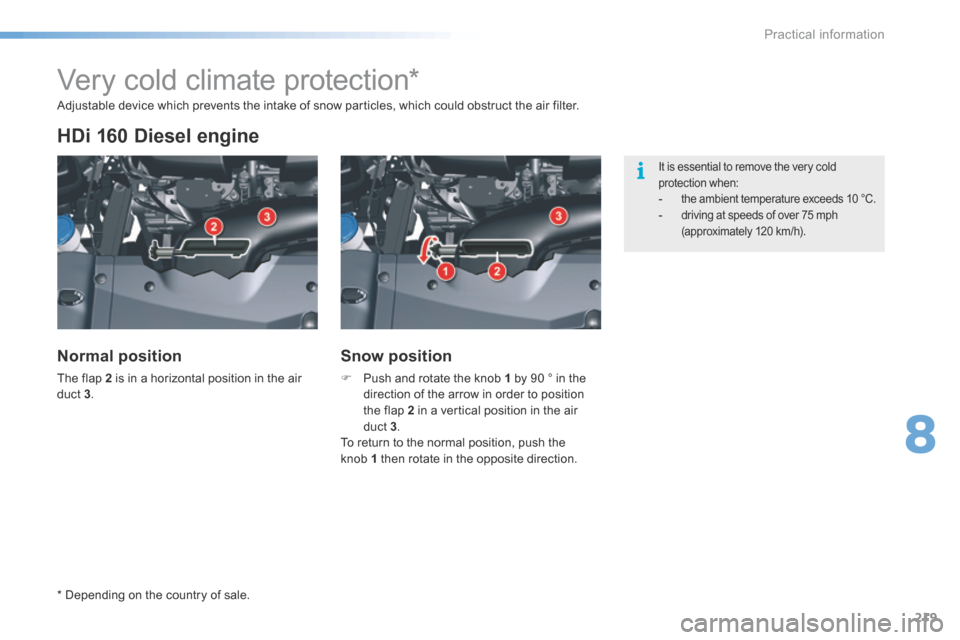
219
Very cold climate protection*
HDi 160 Diesel engine
Normal position
The flap 2 is in a horizontal position in the air
duct 3.
Snow position
F Push and rotate the knob 1 by 90 ° in the
direction of the arrow in order to position
the flap 2 in a vertical position in the air
duct 3 .
To return to the normal position, push the
knob 1 then rotate in the opposite direction.
It is essential to remove the very cold
protection when:
- the ambient temperature exceeds 10 °C.- driving at speeds of over 75 mph
(approximately 120 km/h).
Adjustable device which prevents the intake of snow particles, which could obstruct the air filter.
* Depending on the country of sale.
8
Practical information
Page 222 of 362

220
Cold climate screen*
Fitting
F Offer up the 2 sections of the snow guard
to the upper and lower sections of the front
b u m p e r.
F Press on the surround to clip in one by one
the fixing clips.
Remove
F Using a screwdriver, lever each fixing clip
in turn to disengage them.
Before fitting
After fitting
Don't forget to remove the very cold climate
screen when:
- the ambient temperature exceeds 10 °C,- towing,- When driving at speeds of over 75 mph
(approximately 120 km/h).
Removable screen which prevents the accumulation of snow at the radiator cooling fan.
* Depending on the country of sale.
Practical information
Page 223 of 362

221
* To avoid any risk of jamming of the pedals:
- ensure that the mat is positioned and
secured correctly,
- never fit one mat on top of another.
accessories
"Comfort":
front and rear parking sensors, isotherm
module, reading lamp, sun blinds, headrest-
mounted coat hanger...
"Transport solutions":
boot liner, boot carpet, towbars, towbar wiring
harness, transverse roof bars, bicycle carrier,
ski carrier, roof boxes, boot dividers, boot net,
boot organiser, sliding boot tray, platform on
towbar, ...
"Style":
alloy wheels, rear spoiler, chromed mirror
shells, door sill protectors, gear lever knobs...
"Security and safety":
anti-intrusion alarm, warning triangle and
high visibility vest, breathalyzer, first aid kit,
snow chains, non-skid covers, security wheel
bolts, vehicle tracking system, child seats, fire
extinguisher, caravan mirror, pet cage and seat
belt, dog guard...
"Protection":
mats*, seat covers, mud flaps, bumper
protectors, vehicle covers, door and boot sill
protectors...
A wide range of accessories and genuine parts is available from the CITROËN dealer network.
These accessories and parts are all suitable for your vehicle and benefit from CITROËN's recommendation and warranty.
8
Practical information
Page 224 of 362
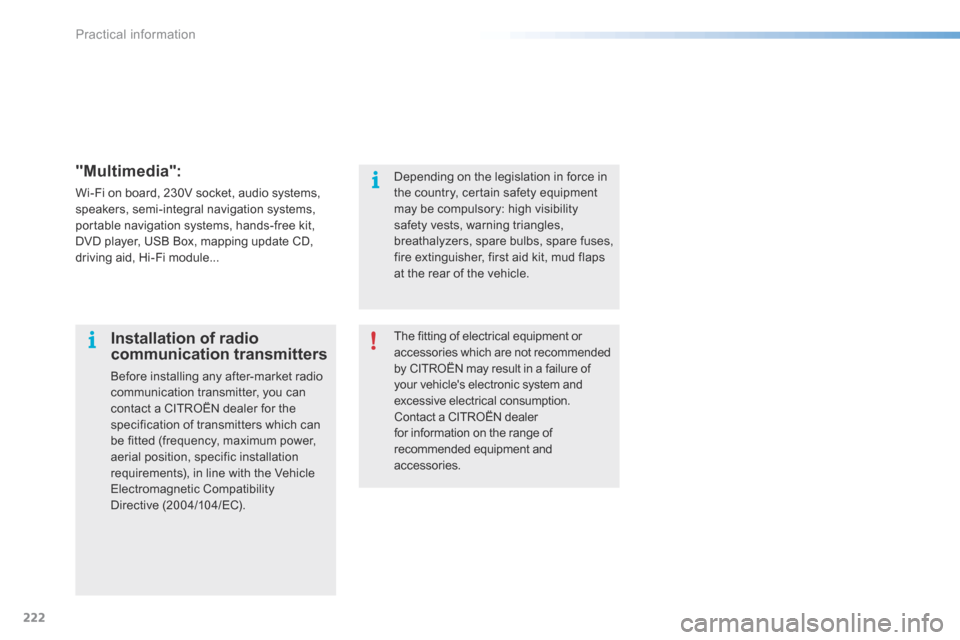
222
"Multimedia":
Wi-Fi on board, 230V socket, audio systems,
speakers, semi-integral navigation systems,
portable navigation systems, hands-free kit,
DVD player, USB Box, mapping update CD,
driving aid, Hi-Fi module...The fitting of electrical equipment or
accessories which are not recommended
by CITROËN may result in a failure of
your vehicle's electronic system and
excessive electrical consumption.
Contact a CITROËN dealer
for information on the range of
recommended equipment and
accessories.
Installation of radio
communication transmitters
Before installing any after-market radio
communication transmitter, you can
contact a CITROËN dealer for the
specification of transmitters which can
be fitted (frequency, maximum power,
aerial position, specific installation
requirements), in line with the Vehicle
Electromagnetic Compatibility
Directive (2004/104/EC). Depending on the legislation in force in
the country, certain safety equipment
may be compulsory: high visibility
safety vests, warning triangles,
breathalyzers, spare bulbs, spare fuses,
fire extinguisher, first aid kit, mud flaps
at the rear of the vehicle.
Practical information
Page 225 of 362

223
ToTaL & CITR oËn
Partners in performance
and protecting
the environment
Innovation in the search for
performance
For over 40 year, the TOTAL Research and
Development departments have developed
lubricants for CITROËN, to match the latest
technical innovations on CITR oËn vehicles, both for
competition and for everyday motoring.
For you, this is an assurance that you will obtain the
best per formance from your engine.
Optimum protection for your
engine
By having your CITROËN vehicle
serviced with TOTAL lubricants, you are
contributing towards improving the life
and per formance of your engine, while
also protecting the environment.
9
Checks
Page 226 of 362

224
bonnet
Opening
F at the front of the bonnet, lift the safety catch B and raise the bonnet.
F Unclip the stay C from its housing and pivot
it to insert it in the notch D indicated by a
yellow arrow.
F Fix the stay in the notch to hold the bonnet
open.Closing
F Take the stay out of the support notch.
F Clip the stay in its housing.
F Lower the bonnet then slam it firmly at the
end of its travel.
F Pull on the bonnet to check that it is fully
closed.
F
Open the left hand front door.
F Pull the interior bonnet release lever A ,
located at the bottom of the door frame. Before doing anything under the bonnet,
switch off the Stop & Start system to
avoid any risk of injury resulting from an
automatic change to START mode.
The location of the interior release lever
prevents opening of the bonnet while
the left hand front door is closed.
This operation must only be carried out
when the vehicle is stationary.
Avoid opening the bonnet in strong
winds.
When the engine is hot, handle the
safety catch and bonnet stay with care
(risk of burns). because of the presence of electrical
equipment under the bonnet, it is
recommended that exposure to water
(rain, washing, ...) be limited.
The cooling fan may star t after
switching off the engine: take care
with articles and clothing that might
be caught by the fan blades.
Checks
Page 227 of 362
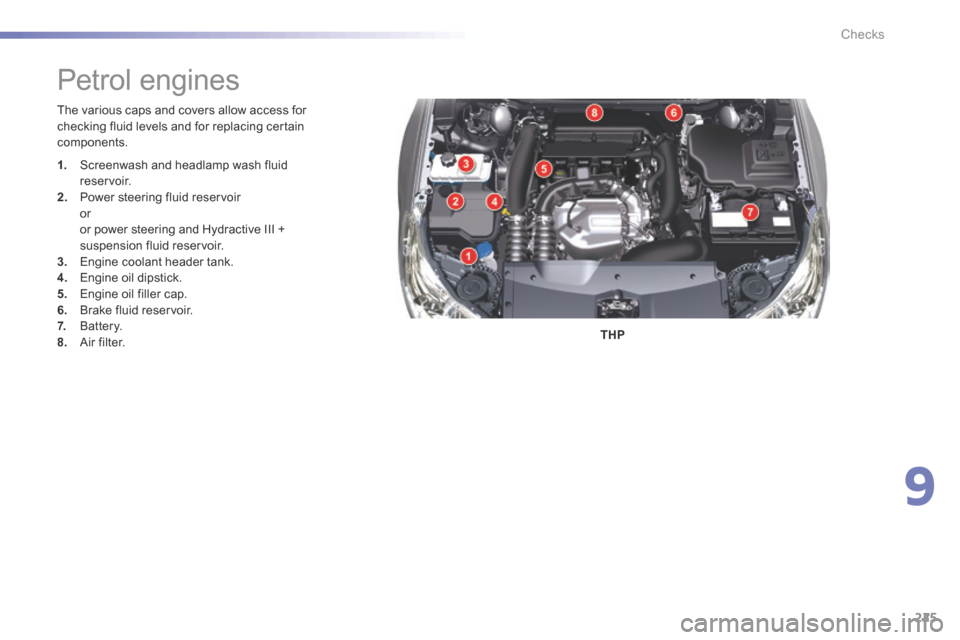
225
The various caps and covers allow access for
checking fluid levels and for replacing certain
components.THP
Petrol engines
1. Screenwash and headlamp wash fluid
reservoir.
2. Power steering fluid reservoir
or
or power steering and Hydractive III +
suspension fluid reservoir.
3. Engine coolant header tank.
4. Engine oil dipstick.
5. Engine oil filler cap.
6. Brake fluid reservoir.
7. Battery.
8. Air filter.
9
Checks
Page 228 of 362
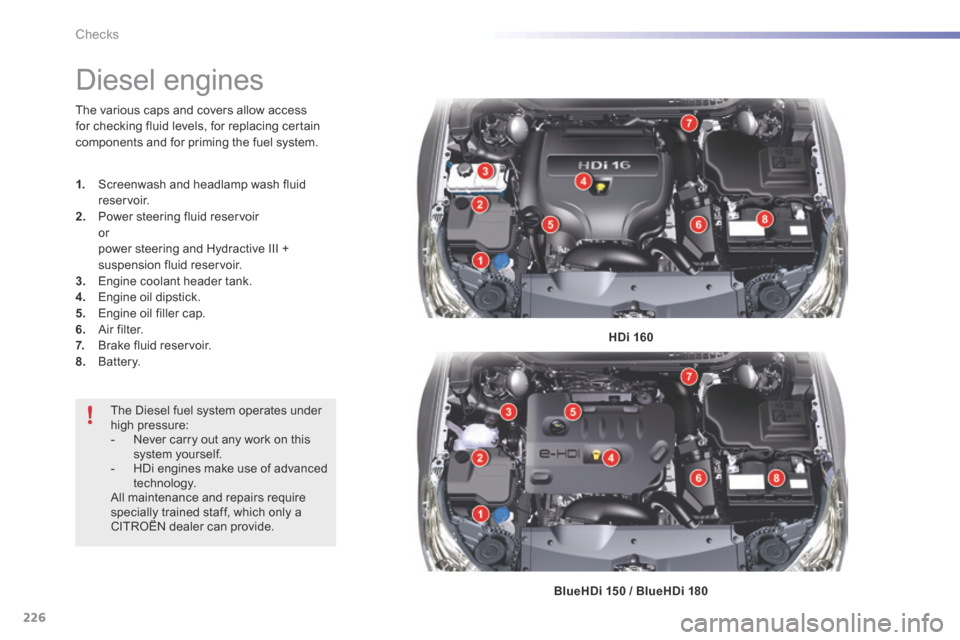
226
Diesel engines
HDi 160
BlueHDi 150 / BlueHDi 180
The various caps and covers allow access
for checking fluid levels, for replacing certain
components and for priming the fuel system.
1.
Screenwash and headlamp wash fluid
reservoir.
2. Power steering fluid reservoir
or
power steering and Hydractive III +
suspension fluid reservoir.
3. Engine coolant header tank.
4. Engine oil dipstick.
5. Engine oil filler cap.
6. Air filter.
7. Brake fluid reservoir.
8. Battery.
The Diesel fuel system operates under
high pressure:
- Never carry out any work on this
system yourself.
- HDi engines make use of advanced
technology.
All maintenance and repairs require
specially trained staff, which only a
CITROËN dealer can provide.
Checks
Page 229 of 362
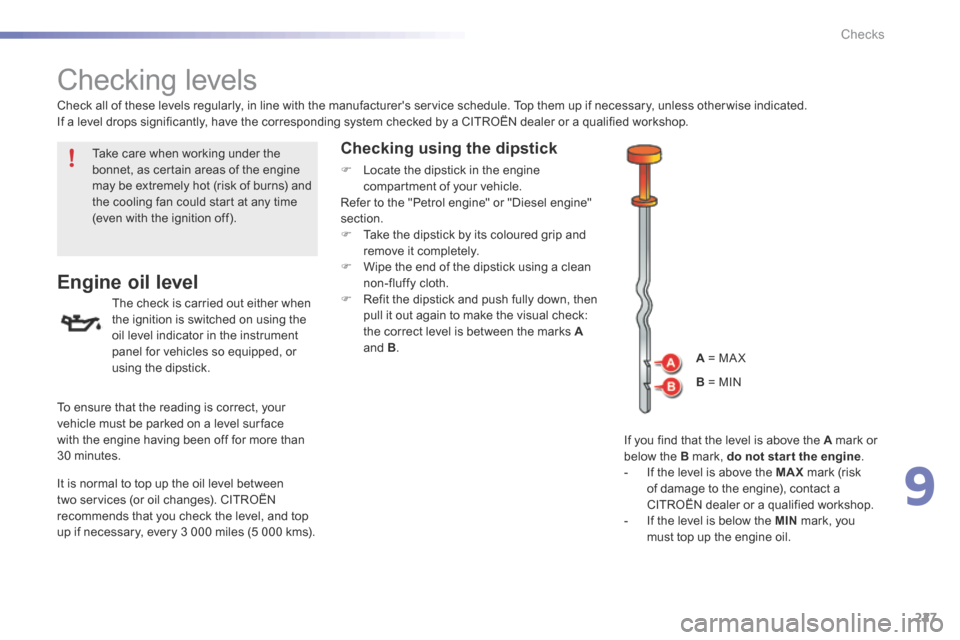
227
Checking levels
Engine oil level
The check is carried out either when
the ignition is switched on using the
oil level indicator in the instrument
panel for vehicles so equipped, or
using the dipstick.
Check all of these levels regularly, in line with the manufacturer's service schedule. Top them up if necessary, unless other wise indicated.
If a level drops significantly, have the corresponding system checked by a CITROËN dealer or a qualified workshop.
If you find that the level is above the A mark or
below the B mark, do not star t the engine.
- If the level is above the MAX mark (risk
of damage to the engine), contact a
CITROËN dealer or a qualified workshop.
- If the level is below the MIN mark, you
must top up the engine oil.
Take care when working under the
bonnet, as certain areas of the engine
may be extremely hot (risk of burns) and
the cooling fan could start at any time
(even with the ignition off).
To ensure that the reading is correct, your
vehicle must be parked on a level sur face
with the engine having been off for more than
30 minutes.
It is normal to top up the oil level between
two services (or oil changes). CITROËN
recommends that you check the level, and top
up if necessary, every 3 000 miles (5 000 kms).
Checking using the dipstick
F Locate the dipstick in the engine
compartment of your vehicle.
Refer to the "Petrol engine" or "Diesel engine"
section.
F Take the dipstick by its coloured grip and
remove it completely.
F Wipe the end of the dipstick using a clean
non-fluffy cloth.
F Refit the dipstick and push fully down, then
pull it out again to make the visual check:
the correct level is between the marks A
and B .
A = MaX
B = MI n
9
Checks
Page 230 of 362
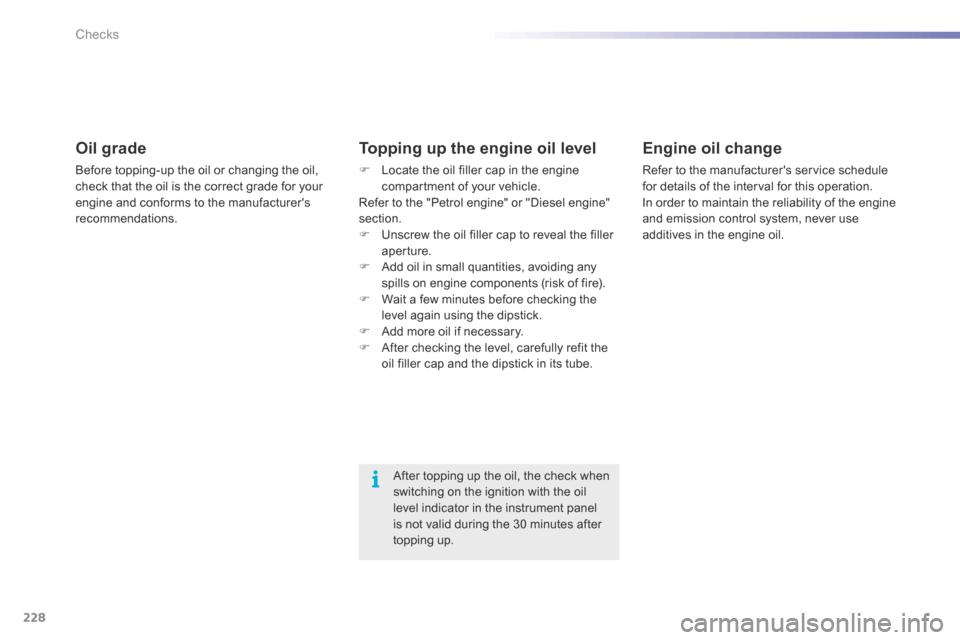
228
Oil grade
Before topping-up the oil or changing the oil,
check that the oil is the correct grade for your
engine and conforms to the manufacturer's
recommendations.
Topping up the engine oil level
F Locate the oil filler cap in the engine
compartment of your vehicle.
Refer to the "Petrol engine" or "Diesel engine"
section.
F Unscrew the oil filler cap to reveal the filler
aperture.
F Add oil in small quantities, avoiding any
spills on engine components (risk of fire).
F Wait a few minutes before checking the
level again using the dipstick.
F Add more oil if necessary.
F After checking the level, carefully refit the
oil filler cap and the dipstick in its tube.
After topping up the oil, the check when
switching on the ignition with the oil
level indicator in the instrument panel
is not valid during the 30 minutes after
topping up.
Engine oil change
Refer to the manufacturer's service schedule
for details of the interval for this operation.
In order to maintain the reliability of the engine
and emission control system, never use
additives in the engine oil.
Checks